Itinerary
We are travelling with Travel the Unknown. Here is our itinerary. For security reasons I’ve obscured any reference to exact dates. Personal notes are added in green.
Click on the map below to see a larger version in a new tab.
View a Map: http://wal.is/1N9CQTP (opens in a new tab/window)
As the site is now password controlled I have updated this itinerary with dates and hotel details. You can also view/print the final itinerary, including flight details, here.
MYSTICAL MYANMAR
Glittering temples, ancient culture & breathtaking beauty
Day 1 – Sat, 12 Nov: Arrival
Arrive in Yangon and be met by a Travel The Unknown representative where you will be transferred to hotel.
You will embark on a half day heritage walk around Yangon in the afternoon.(Starting Time: 13:00 / Ending Time: 17:00)
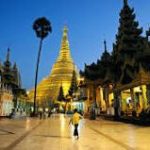 Yangon downtown is unique with much of its colonial-era architecture still standing. You find one of Asia’s most impressive collections of late nineteenth and early twentieth- century buildings, religious and secular. Starting after breakfast or lunch this walking tour will take you through downtown Yangon, focusing on its old colonial buildings. Your guide will walk you through the back streets in a relaxed tempo and explain you the history of each building some of them empty, some getting restored and some used for different purposes than when built. This walk along the streets of Yangon will at least architecturally take you a step back in time. The walk ends with a drink at Rangoon Tea House, a cosy restaurant on lower Pansodan street, a new place where many of Yangon’s expatriates of today meet up for a drink or a meal. Return to hotel and overnight in Yangon.
Yangon downtown is unique with much of its colonial-era architecture still standing. You find one of Asia’s most impressive collections of late nineteenth and early twentieth- century buildings, religious and secular. Starting after breakfast or lunch this walking tour will take you through downtown Yangon, focusing on its old colonial buildings. Your guide will walk you through the back streets in a relaxed tempo and explain you the history of each building some of them empty, some getting restored and some used for different purposes than when built. This walk along the streets of Yangon will at least architecturally take you a step back in time. The walk ends with a drink at Rangoon Tea House, a cosy restaurant on lower Pansodan street, a new place where many of Yangon’s expatriates of today meet up for a drink or a meal. Return to hotel and overnight in Yangon.
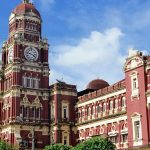 There are many colonial buildings scattered around Yangon. The buildings are evidence of the history of British rule. Downtown Yangon is known for the highest number of colonial period buildings in Southeast Asia. The most iconic of these buildings include the former Secretariat buildings, the City Hall, the High Court, the Strand Hotel and the former Inland Water Transport building.
There are many colonial buildings scattered around Yangon. The buildings are evidence of the history of British rule. Downtown Yangon is known for the highest number of colonial period buildings in Southeast Asia. The most iconic of these buildings include the former Secretariat buildings, the City Hall, the High Court, the Strand Hotel and the former Inland Water Transport building.
Overnight in Yangon Heritage Hotel, Yangon.
Day 2 – Sun, 13 Nov: Yangon – Lashio – Hsipaw
After breakfast, you will be transferred to the airport to connect to your flight to Lashio. Transfer from Lashio to Hsipaw (90 minutes) where you will have the rest of the day free at leisure. Overnight in Hsipaw.
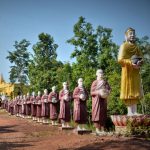 Once a Shan Royal City, the town of Hsipaw lies on the Duthawadi River. It was known as being one of the most powerful and wealthy Saopha states in Shan State. The Saophas played an important role in both in state and national politics from the 11th century to the 1962 military coup. Local historians claim that in the 19th century, Prince Sao So Chae was knighted by Queen Victoria. In contrast to this, the last Prince, Sao Kya Seng, became the tragic hero is his wife’s novel. The town is home to Bowgoy Pagoda and is surrounded by awe inspiring natural beauty, making it the ideal base for anyone wanting to visit the hill tribes.
Once a Shan Royal City, the town of Hsipaw lies on the Duthawadi River. It was known as being one of the most powerful and wealthy Saopha states in Shan State. The Saophas played an important role in both in state and national politics from the 11th century to the 1962 military coup. Local historians claim that in the 19th century, Prince Sao So Chae was knighted by Queen Victoria. In contrast to this, the last Prince, Sao Kya Seng, became the tragic hero is his wife’s novel. The town is home to Bowgoy Pagoda and is surrounded by awe inspiring natural beauty, making it the ideal base for anyone wanting to visit the hill tribes.
Total travel time : 90 minutes
Overnight in Mr. Charles, Hsipaw
Day 3 – Mon, 14 Nov: Hsipaw
In the late afternoon your guide will take you for a 2.5 hour walk through a panoramic scenery of paddy fields and other seasonal crops passing small creeks, Shan villages and local schools and monasteries. The guide will explain in detail about Shan life around Hsipaw and show you some home industries like cheroot (cigar) rolling and bamboo weaving. He will explain why each Shan village has a spirit house build at the entrance of the village and make sure you will get to know the spirit of the local people in Northern Shan state. Overnight in Hsipaw.
Overnight in Mr. Charles, Hsipaw
Day 4 – Tue, 15 Nov: Hsipaw – Kyaukme
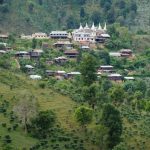 Take a local bus to Kyaukme departing at about 07:30, where a Travel The Unknown representative will meet and transfer you to your guest house. After check-in, you will take a trip by taxi in the surrounding areas of Kyaukme visiting at least one hill tribe.
Take a local bus to Kyaukme departing at about 07:30, where a Travel The Unknown representative will meet and transfer you to your guest house. After check-in, you will take a trip by taxi in the surrounding areas of Kyaukme visiting at least one hill tribe.
Kyaukme is a town in the North of Shan State and has been the main trading centre for tea from Tawngpeng since before British colonial rule. During the Second World War, bombing raids were carried out on the station, tracks, roads and Japanese troops in the area. The town has some beautiful colonial buildings and busy markets and is well known for its trekking. The hills that surround the town are inhabited by the Palaung, an ethnic minority that also live in the Yunnan province of China as well as Northern Thailand. They are followers of Thervada Buddhism and temples can be found in many towns as the religion is present in the everyday life of the Palaung.
Total travel time : 1 hour
Overnight in One Love Hotel, Kyaukme
Day 5 – Wed, 16 Nov: Kyaukme – Pyin Oo Lin – Mandalay
In the morning you have some free time to explore the town with its colonial buildings and the busy and colourful market where we suggest you buy food and drinks for the train. A 10 minute walk will lead you to the train station. We have reserved seats for you till Pyin Oo Lwin station on the spectacular train crossing the mighty Gokteik Viaduct which was constructed in 1901 by constructors from the Pennsylvania Steel company and was once the second highest railway bridge in the world.
Th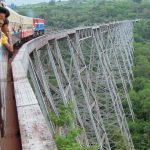 e train departs at 11:05 from Kyaukme station and will pass cross the Gokteik viaduct around 13:30. Through spectacular mountain scenery the train will slowly move forward over the old railway track passing small villages and towns where vendors will enter the train to sell drinks and local snacks. Expected arrival time in the Pyin Oo Lwin – the former summer capital for the British colonial administration – around 16:00, but be warned: there might be delays with a historic railway like this one. To make sure you get out at the correct station please inform other passengers that you need to get out at Pyin Oo Lwin station.
e train departs at 11:05 from Kyaukme station and will pass cross the Gokteik viaduct around 13:30. Through spectacular mountain scenery the train will slowly move forward over the old railway track passing small villages and towns where vendors will enter the train to sell drinks and local snacks. Expected arrival time in the Pyin Oo Lwin – the former summer capital for the British colonial administration – around 16:00, but be warned: there might be delays with a historic railway like this one. To make sure you get out at the correct station please inform other passengers that you need to get out at Pyin Oo Lwin station.
We suggest you leave around 10:15 for Kyaukme train station which is about 10 minutes walk from the guest house. Somebody from the guest house will walk with you and give you the train ticket. If you don’t want to walk you can hire a motorbike taxi with trailer. You could also go to the Kyaukme market in the morning and buy water, biscuits, bananas, etc. for your lunch in the train today. Buying a small pillow to sit on could be useful as well as the train has only hard wooden seats.
Upon arrival, be met by a private taxi who will transfer you to the hotel in Mandalay (1.5 hour drive). Overnight in Mandalay.
Mandalay is a relatively young city, aged 150 years old. It was founded as the capital of the Burmese empire in 1861 and saw the last king of Burma before the British took over in 1885.
Total travel time : 6½ hours
Overnight in Ayarwaddy River View Hotel, Mandalay
Day 6 – Thu, 17 Nov: Mandalay
Morning free (additional sightseeing to Mahamuni Temple and Amarapura can also be arranged). In the afternoon, proceed on a half day boat cruise, which will take you to Mingun. There, you will visit the Mingun ‘Unfinished Pagoda’ and the Mingun Bell. Later, return to Mandalay to discover the lively Yadanabon market which starts around 15:00 before returning ot the hotel at about 18:00. Overnight in Mandalay.
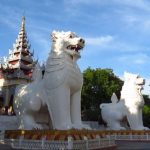 Amarapura literally translates to ‘City of Immortality’ and is located on the left bank of the Irrawaddy River. It was claimed as the capital of Myanmar by King Bodawpaya in 1783 – intended to represent a fresh start for the people upon his accession to the throne. There are many workshops which make Longyis (traditional waist garments) using the loom.
Amarapura literally translates to ‘City of Immortality’ and is located on the left bank of the Irrawaddy River. It was claimed as the capital of Myanmar by King Bodawpaya in 1783 – intended to represent a fresh start for the people upon his accession to the throne. There are many workshops which make Longyis (traditional waist garments) using the loom.
The Mingun Unfinished Pagoda was a huge project started by King Bodawpaya in 1790, of which he intended it to be the largest pagoda in the country. The pagoda was left at a third of the intended height when the king died in 1819, thus earning the title of Mingun Unfinished Pagoda.
In 1810 the enormous Mingun Bell, that King Bodawpaya had requested to go with his gigantic soon to be finished pagoda, was built. Weighing 90 tons it is the second heaviest hung, uncracked, functioning bell in the world behind the Chinese bell of good luck which was recently cast in 2000. The bell is about four metres high and over five metres in diameter at the bottom. It can fit people standing inside and, if you desire, you can get someone to ring it so that you can hear it ring from the inside.
Overnight in Ayarwaddy River View Hotel, Mandalay
Day 7 – Fri, 18 Nov: Mandalay – Bagan
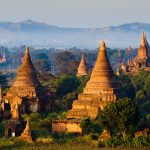 After breakfast you will be transferred to the airport to connect to your flight to Bagan. Upon arrival, you will be met by a Travel The Unknown representative and will set off for a full day tour of Bagan by car with an experienced guide who will show you the best known temples of the area. You start the day climbing a pagoda to get an first impressive view over the whole area. From here the guide plans his way to some of the other amazing temples that have been here for hundreds of years. Places like the Ananda, Dhammayangyi, Sulamani, and Thatbyinnyu will certainly impress you. Lunch will be taken at a local restaurant and at around 16:00 you continue the tour by horse cart to Pyathagyi pagoda for sunset with some refreshing drinks served. Oh… we forgot to mention the best part of this tour; whenever you see a temple you like, just ask you guide to stop to have a look at it – simply pick your own favourite temple. Overnight in Bagan.
After breakfast you will be transferred to the airport to connect to your flight to Bagan. Upon arrival, you will be met by a Travel The Unknown representative and will set off for a full day tour of Bagan by car with an experienced guide who will show you the best known temples of the area. You start the day climbing a pagoda to get an first impressive view over the whole area. From here the guide plans his way to some of the other amazing temples that have been here for hundreds of years. Places like the Ananda, Dhammayangyi, Sulamani, and Thatbyinnyu will certainly impress you. Lunch will be taken at a local restaurant and at around 16:00 you continue the tour by horse cart to Pyathagyi pagoda for sunset with some refreshing drinks served. Oh… we forgot to mention the best part of this tour; whenever you see a temple you like, just ask you guide to stop to have a look at it – simply pick your own favourite temple. Overnight in Bagan.
Bagan is an ancient city located in central Myanmar and was the capital of the first Myanmar Empire. There were many monuments built in Bagan during this time but sadly were damaged by invaders and by the fleeing king who needed the materials for defence structures instead. The ruins today are a place of worship and, being one of the richest archaeological sites in South-east Asia, Bagan has been a popular tourist destination for almost a thousand years.
Overnight in Thazin Garden Hotel, Bagan
Day 8 – Sat, 19 Nov: Bagan
Today is free to explore Bagan at your leisure. Overnight in Bagan.
Overnight in Thazin Garden Hotel, Bagan
Day 9 – Sun, 20 Nov: Bagan – Heho – Kalaw
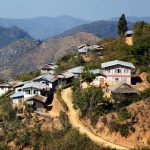 Breakfast at the hotel before being transferred to Nyaung U airport for flight to Heho and transfer to Kalaw. On arrival transfer to the elephant conservation area. Depending on your arrival time and how long you want to walk through the forest (walks from 30 min up to 4-5 hours are possible – simply let us know what you prefer) you will find yourself in the natural surroundings of Asian jungle. Your guide is specialised in elephant conservation and will take you for a rewarding day in the forest surrounding Kalaw encountering elephants, their mahouts and people living in the surrounding area.
Breakfast at the hotel before being transferred to Nyaung U airport for flight to Heho and transfer to Kalaw. On arrival transfer to the elephant conservation area. Depending on your arrival time and how long you want to walk through the forest (walks from 30 min up to 4-5 hours are possible – simply let us know what you prefer) you will find yourself in the natural surroundings of Asian jungle. Your guide is specialised in elephant conservation and will take you for a rewarding day in the forest surrounding Kalaw encountering elephants, their mahouts and people living in the surrounding area.
A delicious lunch with local specialities (often from Nepalese origin) will be served in a traditional village, in the jungle or in the camp. After lunch it is time to help the mahout washing and feeding the elephant. Walk back in the afternoon to the main road and continue by car back to Kalaw town. Rest of evening free. Overnight in Kalaw.
Young tourism professionals originating from Kalaw decided to set-up a project in Kalaw that is focused on protecting the nature, elephants and traditions of local people living in an area close to Kalaw. In a large part of this private protected forest nature can grow undisturbed creating a natural habitat for animals that could otherwise be easily hunted down and killed. The project includes creating a natural environment for some of Myanmar’s elephants from this part of the world and helping the local population to grow out of the vicious circle of poverty through education and micro finance.
Kalaw is a hill town in the Shan State of Myanmar. It is located in Kalaw Township in the Taunggyi District. The town was popular with the British during colonial rule and used as a British hill-station. The town offers some of the best trekking in Myanmar and is surrounded by a tranquil forest. It has a variety of cultures thanks to large populations of Nepalese Gurkhas, Hindus, Sikhs and Muslims whose descendents came to Kalaw to build roads and railways during British colonial rule. It was also the main setting of the novel ‘The Art of Hearing Heartbeats’ by Jan-Philipp Sendker.
Overnight in Royal Kalaw Hills Resort, Kalaw
Kalaw is where my grandfather built a house to stay in during the summer. It is now the Royal Kalaw Hills Resort hotel and we will be staying there when we’re in Kalaw.
Day 10 – Mon, 21 Nov: Kalaw – Lake Inle
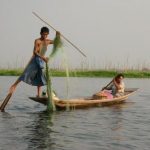 Set off by bike from Kalaw to Lake Inle (optional). Mountain bikes are ready for you to start a 4-5 hour biking trip to Indein. The trip is mostly off-road and technically easy with most of the roads flat or downhill although the first hour some parts are going uphill. Biking through numerous Pa O tribal villages in an area where few foreigners have been before is a great experience. Stop on the way to enjoy the fantastic views over the lake and the Shan countryside. Lunch is included in a local village and at the end of the trip we visit the ancient ruins of Indein. From Indein we continue to your hotel by private motorboat where your luggage is already delivered in the room. Overnight at Lake Inle.
Set off by bike from Kalaw to Lake Inle (optional). Mountain bikes are ready for you to start a 4-5 hour biking trip to Indein. The trip is mostly off-road and technically easy with most of the roads flat or downhill although the first hour some parts are going uphill. Biking through numerous Pa O tribal villages in an area where few foreigners have been before is a great experience. Stop on the way to enjoy the fantastic views over the lake and the Shan countryside. Lunch is included in a local village and at the end of the trip we visit the ancient ruins of Indein. From Indein we continue to your hotel by private motorboat where your luggage is already delivered in the room. Overnight at Lake Inle.
People who don’t want to bike will travel by car (about 1.5 hour) and private boat (about 1 hour) to Indein for lunch and continue to the hotel.
Inle Lake is the second largest lake in Myanmar. The 70,000 people of Inle Lake, the Intha, live in four cities around the lake and in small villages along the lake’s shores, and on the lake itself, building their houses on stilts and travelling across the lake using their unique style of leg-rowing. The locals bind together water hyacinth to cultivate floating gardens that drift around the waters. The lake is also home to over twenty species of snail and nine species of fish not found anywhere else in the world.
Overnight in Golden Island Cottages, Inle Lake
Day 11 – Tue, 22 Nov: Lake Inle
Breakfast at the hotel.In the south of the lake the ruins of Indein are certainly worth a visit. Partly covered by vegetation the area looks like a pagoda forest. We walk about 1 hour to enjoy a fantastic view over the lake and visit a school in Tha Ley village. A homemade cooked lunch is served by a local family in their house. We continue towards the Nam Pan village for a very interesting trip going local with a small canoe. Whenever you are tired peddling yourself we continue by motorboat back to your hotel. Overnight at Inle Lake.
Other must-see parts of Lake Inle are the floating villages and markets. Around 80,000 people live on the lake in “floating” villages which are collections of houses built on stilts and organised into rows of neighbourhoods. These are home to people from the Intha Tribe but many local tribes come down from the surrounding mountains for the market which also takes place on the lake.
Overnight in Golden Island Cottages, Inle Lake.
Day 12 – Wed, 23 Nov: Lake Inle – Yangon
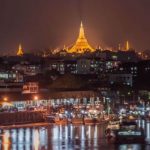 After breakfast you will be transferred to Heho to connect to your flight to Yangon. On arrival in Yangon, you will travel to Shwedagon Pagoda for a half-day sightseeing tour.
After breakfast you will be transferred to Heho to connect to your flight to Yangon. On arrival in Yangon, you will travel to Shwedagon Pagoda for a half-day sightseeing tour.
So what is behind the golden façade of the Shwedagon Pagoda? During this interactive half day tour we take you through the back door and show you the full history of the pagoda, the daily life of all people living in the immediate surroundings of the pagoda and a deeper insight in the Buddhist religion and how the spiritual belief is mixed with the belief in nats – the Myanmar spirits. An intriguing half day tour starting from the bottom of the hill and passing the workshops, markets and monasteries which will be useful or even essential to understand more of the country during the rest of your journey. The tour includes a visit to a fortune teller and a Burmese lunch. Overnight in Yangon.
The 2,500 year-old Shwedagon Pagoda is the most impressive and sacred Buddhist pagoda for the people of Myanmar. Standing just under 110m, it can be seen from almost everywhere in the city. It is stunning with its gold plate coating that reflects the sun. The crown is tipped with 5,448 diamonds and 2,317 rubies. At the very top, the diamond tip is a 76 carat diamond. This was also the stage for a speech given by pro-democracy leader, Aung San Suu Kyi, in 1988.
Overnight in East Hotel, Yangon
Day 13 – Thu, 24 Nov: Yangon – Kyaikhtiyo
Leave around 07:30 from your hotel in Yangon by private car and guide and visit (if wanted) after an hour the war cemetery in Taukkyan where thousands of prisoners of war who worked on the death railway in Kayin and Mon State are commemorated.
You continue towards Mon State. On arrival in Kyaiktiyo basecamp (around 11 am) – total about 3-4 hours drive you go up the hill by trucks serving mainly local pilgrims.
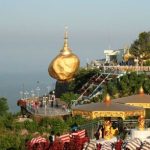 One of the most important pilgrimage sites for Myanmar Buddhist and maybe one of the strangest (or unbelievable) sites for foreign tourists: the Golden Rock (Kyaiktiyo Pagoda). A big rock with a small pagoda built on top of it, is balancing on the edge of a mountain and looks as if it could tumble into the ravine below at any moment (luckily some hairs of Buddha precisely placed in the pagoda prevent the rock from falling). The site can be reached after a short walk (1.5 hours) or a long walk (about 7 hours) and rumour has it that taking the long route for 3 times in a lifetime will bring good luck. Surrounding the Golden Rock are numerous local teashops, resting places and monasteries as well as local souvenir shops (many of them offering traditional Myanmar medicine made from indigenous animals found by Kayin hunters living in the jungle in this region).
One of the most important pilgrimage sites for Myanmar Buddhist and maybe one of the strangest (or unbelievable) sites for foreign tourists: the Golden Rock (Kyaiktiyo Pagoda). A big rock with a small pagoda built on top of it, is balancing on the edge of a mountain and looks as if it could tumble into the ravine below at any moment (luckily some hairs of Buddha precisely placed in the pagoda prevent the rock from falling). The site can be reached after a short walk (1.5 hours) or a long walk (about 7 hours) and rumour has it that taking the long route for 3 times in a lifetime will bring good luck. Surrounding the Golden Rock are numerous local teashops, resting places and monasteries as well as local souvenir shops (many of them offering traditional Myanmar medicine made from indigenous animals found by Kayin hunters living in the jungle in this region).
You have the whole afternoon to visit the site and return by truck (about 30 min) (or on foot if you prefer) to Kin Pun basecamp. Overnight in Kyaikhtiyo.
Drive to the stunning Kyaikhtiyo Pagoda, also known as Golden Rock, due to it being built on the top of a granite boulder covered with gold leaves pasted on by Buddhist devotees. According to legend, the Golden Rock itself is precariously perched on a strand of the Buddha’s hair. The balancing rock seems to defy gravity, as it perpetually appears to be on the verge of rolling down the hill. The rock and the pagoda are at the top of Mt. Kyaikhtiyo. It is the third most important Buddhist pilgrimage site in Myanmar after the Shwedagon Pagoda and the Mahamuni Pagoda. Legend also mentions that pilgrims undertaking the pilgrimage by trekking from the Kinpun base camp three times consecutively in a year will be blessed with wealth and recognition.
Kyaikhtiyo (Golden Rock) is a well-known Buddhist pilgrimage site in Mon State, Myanmar. It is a small pagoda (7.3m) built on the top of a granite boulder covered with gold leaves pasted on by devotees. According to legend, the Golden Rock itself is precariously perched on a strand of the Buddha’s hair. The rock seems to defy gravity, as it perpetually appears to be on the verge of rolling down the hill. The rock and the pagoda are at the top of Mt. Kyaikhtiyo. It is the third most important Buddhist pilgrimage site in Myanmar after the Shwedagon Pagoda (Yangon) and the Mahamuni Pagoda (Mandalay). A glimpse of the “gravity defying” Golden Rock is believed to be enough of an inspiration for any person to turn to Buddhism.
Overnight in Golden Sunrise, Kyaikhtiyo
Day 14 – Fri, 25 Nov: Kyaikhtiyo – Mawlamyine
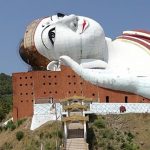 Travel by car to Mawlamyine. On arrival visit a local house and enjoy a home-cooked lunch. In the afternoon, proceed to Mon Museum to learn more about the rich Mon culture. Continue to the nearby village of Hpa Ouk, famous for its weaving and traditional Mon
Travel by car to Mawlamyine. On arrival visit a local house and enjoy a home-cooked lunch. In the afternoon, proceed to Mon Museum to learn more about the rich Mon culture. Continue to the nearby village of Hpa Ouk, famous for its weaving and traditional Mon
sarongs. Overnight in Mawlamyine.
Mawlamyine is one of the Orient’s most picturesque ports. In the heart of Lower Myanmar, it is famous for being the site of Kipling’s Pagoda. Not far from here is the Thanbyuzayat Cemetery, a memorial to the Allied troops lost in World War Two. Accessible only by road and a full day’s drive from Yangon, this town sees few visitors but the journey itself is worthwhile, passing through Mon and Karen villages and stopping at various interesting cave temples en route. The city features in the opening lines of Kipling’s poem ‘Mandalay’ and as the setting for George Orwell’s 1936 memoir ‘Shooting an Elephant’.
Total travel time : 4 hours
Overnight in Cinderella Hotel, Mawlamyine
My grandmother was born in Moulmein (Mawlamyine), though I don’t have any more information than that.
Day 15 – Sat, 26 Nov: Mawlamyine – Hpa An
Breakfast at the hotel and you will be picked up around 08:00 am to visit the Seindon Mibaya Monastery.
The last king of Myanmar, at the palace in Mandalay, came to power by killing many of the rival heirs to the throne at the end of the 19th century. Queen Seindon escaped and moved to what was called Moulmein in that period and became a Buddhist nun till her death (her tomb is in the compound in one of the nunneries). She built the Seindon Mibaya Monastery in Mawlamyine which is very fine example of architecture in the original Mandalay palace and has magnificent woodcarvings and other decorations. It’s a monastery so beautiful that one could actually call it a museum.
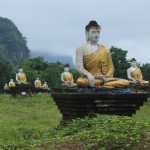 Continue to the Ni Paya to have a view over the city and river before heading to the jetty and board a private motor boat that will bring you to Hpa An. Around 10:00 you will take a private boat for a cruise over the Thanlwin (Salween) River – one of the longest rivers in Myanmar ending in Mon State. After about an hour you will arrive at a small jetty in U Na Auk village from where you will get on a tuk-tuk to visit the amazing carvings and decorations or the temples and ordination hall donated to the village by Mr Na Auk. Mr Na Auk was a Mon trader, living in this area in the British period and he was famous for his intelligence to trade and win from the big British companies and has been a symbol of being patriotic, have a good trading sense and be kind to his fellow country man. In modern school books his story is taught and everybody in the country knows his name and stories how he offered free transportation for the local people in his area, offered food and managed to compete with the British traders.
Continue to the Ni Paya to have a view over the city and river before heading to the jetty and board a private motor boat that will bring you to Hpa An. Around 10:00 you will take a private boat for a cruise over the Thanlwin (Salween) River – one of the longest rivers in Myanmar ending in Mon State. After about an hour you will arrive at a small jetty in U Na Auk village from where you will get on a tuk-tuk to visit the amazing carvings and decorations or the temples and ordination hall donated to the village by Mr Na Auk. Mr Na Auk was a Mon trader, living in this area in the British period and he was famous for his intelligence to trade and win from the big British companies and has been a symbol of being patriotic, have a good trading sense and be kind to his fellow country man. In modern school books his story is taught and everybody in the country knows his name and stories how he offered free transportation for the local people in his area, offered food and managed to compete with the British traders.
You continue the boat trip over the Thanlwin River with spectacular sights on Zwekabin and other limestone mountains rising from the rice fields. Lunch is served on board the boat (total boat trip about 4-5 hours). Arrive around 16:00 in Hpa An and transfer by car to the hotel which is situated at the bottom of one of the limestone mountains. Overnight at Hpa An.
Hpa An is the small but bustling capital of Kayin state, located close to the border with Thailand and is rarely visited by western travellers. Hpa An is surrounded by limestone mountains with the tallest being Mt. Zwekabin where close by you can visit impressive Kawgun Cave. Hidden away in the hills the caves were discovered in 1975 and contains thousands of 7th century tiny clay Buddhas and carvings, hidden precariously over the walls and roof of the main cave.
Overnight in Thiri Hpa An Hotel, Hpa An
Day 16 – Sun, 27 Nov: Hpa An – Yangon
Be prepared for a soft adventure day with a lot of activities and a chance to experience real Kayin lifestyle. We start the day by going for a leisurely trip by kayak through the paddy fields for half an hour or so. If you don’t feel like paddling yourself, let us know and we arrange a local Kayin man to paddle for you.
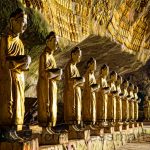 We leave the kayaks behind and continue on foot through the forest visiting Kayin villages for a leisurely walk of about an hour. This is a great trip to get a feel for the real Kayin life in the jungle. From here we continue for another 1,5 hours passing several other Kayin villages. We then take the kayaks again for half an hour bringing us to a beautiful traditional local house where a home cooked lunch awaits you, served by the local host.
We leave the kayaks behind and continue on foot through the forest visiting Kayin villages for a leisurely walk of about an hour. This is a great trip to get a feel for the real Kayin life in the jungle. From here we continue for another 1,5 hours passing several other Kayin villages. We then take the kayaks again for half an hour bringing us to a beautiful traditional local house where a home cooked lunch awaits you, served by the local host.
Afterwards we continue by kayak to our starting point from where we continue to explore the famous Saddar cave. Note: as the creeks in this rural part are quite shallow we use small kayaks to travel around which means that you could get wet – slippers, shorts and a t-shirt are recommended. It is possible to shorten the village walk.
We continue driving back to Yangon (approx 4.5 hours) leaving two very interesting states in Myanmar behind us. Arrive in Yangon around dinner time. Overnight in Yangon.
Travel The Unknown wants to support local communities and therefore we decided to have this part of the tour accompanied by local people who have limited English skills but love their area and will lead you though their community with pride.
Overnight in Yangon Heritage Hotel, Yangon
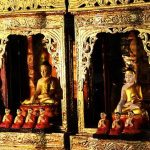 Day 17 – Mon, 28 Nov: Yangon
Day 17 – Mon, 28 Nov: Yangon
Free day in Yangon. We booked an extra day to relax and unwind and get to know Yangon better.
Overnight in Yangon Heritage Hotel, Yangon
My mother was born in Bassein (Pathein), outside Rangoon (Yangon). I will investigate the possibility of visiting there.
Day 18 – Tue, 29 Nov: Departure
Transfer to the airport to catch your flight home.
View a Map: http://wal.is/1N9CQTP (opens in a new tab/window)
View/download a PDF file (opens in a new tab/window)
2 Responses to Itinerary
Leave a Reply
You must be logged in to post a comment.
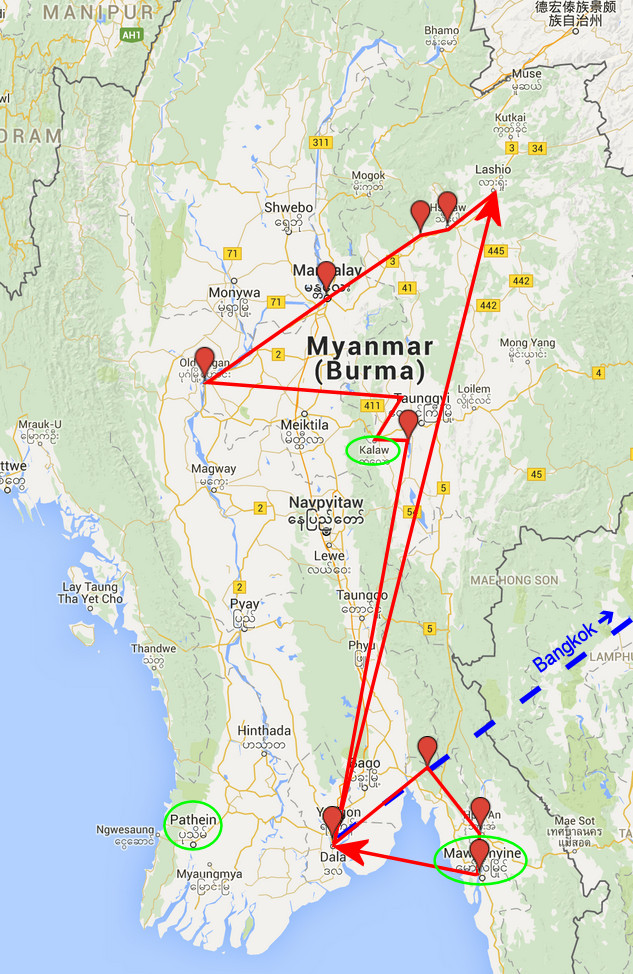
Done already! – Thanks. I tried to look judicial, but somebody made me laugh…
Hi Toby
Make sure you get a selfie outside the High Court, where Grandfather worked.